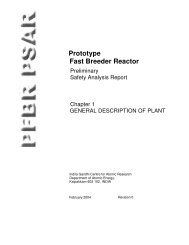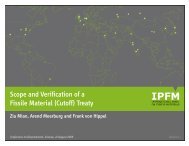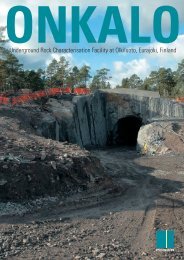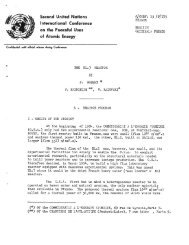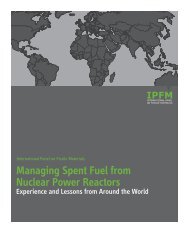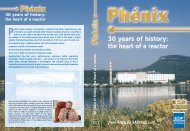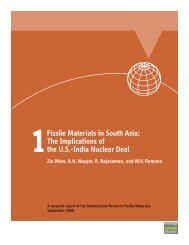Nuclear Proliferation TechnologyTrends Analysis - International ...
Nuclear Proliferation TechnologyTrends Analysis - International ...
Nuclear Proliferation TechnologyTrends Analysis - International ...
Create successful ePaper yourself
Turn your PDF publications into a flip-book with our unique Google optimized e-Paper software.
PNNL -14480<br />
China and Russia are collaborating on design and engineering for advanced centrifuges.<br />
China has made substantial progress in indigenous development of centrifuges using<br />
composite carbon fiber 40 .<br />
This is a good example of a minimum time to develop an enrichment facility. It<br />
essentially took three years to get the facility into operation, including constructing the<br />
buildings and installing the centrifuges. This particular facility was co-located with an<br />
older gaseous diffusion plant, so UF 6 handling facilities already existed there and did not<br />
need to be developed.<br />
3.2.3.8 United States<br />
The United States had an early centrifuge research program, first enriching uranium at the<br />
University of Virginia in 1941. Approximately 1.2g of 4% enriched uranium was<br />
produced in this initial attempt. This first centrifuge, known as a “Beams”-type<br />
centrifuge after its inventor, had a length of 3.35 meters.<br />
For a variety of reasons, development of centrifuge enrichment in the United States<br />
stopped until 1958, when information about work in the Soviet Union became available.<br />
In 1965, a demonstration centrifuge (SET I) was built, followed by SET II in 1967, and<br />
SET III in 1969. While a pilot plant was built in 1978 to demonstrate the technology, the<br />
centrifuge program was canceled in 1985 in favor of concentrating on laser enrichment<br />
technology (AVLIS).<br />
The United States had a different centrifuge design philosophy than Urenco. Urenco<br />
designed for many small machines with very low failure rates, with no maintenance,<br />
while the United States went for fewer, far bigger machines and planned to repair them.<br />
It was reported that individual machine throughput was 300 swu/yr 41 . United States<br />
centrifuges were 50 cm in diameter, 15 meters long 42 . Compare this to the 5 cm diameter,<br />
50 to 100 cm long machines being developed in other countries at the same time. High<br />
failure rates and what was thought to be a more promising technology halted U.S.<br />
centrifuges 43 development.<br />
3.2.3.9 Iraq<br />
Like Pakistan, Iraq planned to develop centrifuge enrichment technology through<br />
surreptious acquisition. It is reported 44 that Iraq attempted to develop centrifuge<br />
technology based on Urenco G1/G2 technology. This program was to be made possible<br />
through acquisition of equipment, plans, and models from France, Germany, Switzerland,<br />
Liechtenstein, 45 and Pakistan 46 .<br />
40 <strong>Nuclear</strong> Fuel, Vol. 24, No 10: pg 11, Mark Hibbs, 5/17/1999<br />
41 Fuel Issues, Plans for an Enriched Future, Dennis Spurgeon, <strong>Nuclear</strong> Engineering <strong>International</strong>, pg 44, 3/31/2002<br />
42 In the beginning was uranium….., Dan Charles, New Scientist; Vol.136; No 1844; pg 30, 10/24/1992<br />
43 Uranium Enrichment: why the U.S. is turning to lasers, David Fishlock, Financial Times (London) Section I; Technology; pg 6,<br />
9/16/1985<br />
44 Iraqi Evidence Points to Unknown Enrichment Mentor, Mark Hibbs, Nucleonics Week, Vol.32, No 34; pg 7, 8/22/1991<br />
45 The trail of secrets that gave Saddam deadly power, The Sunday Times, 12/16/1990<br />
46 Special Report: How Saddam got the bomb, Mednews - Middle East Defense News; <strong>Proliferation</strong>; Vol. 5, No. 1, 10/14/1991<br />
26



